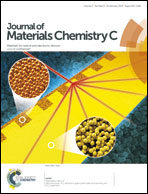Low temperature electrical transport and photoresponsive properties of H-doped MoO3 nanosheets†
Abstract
α-MoO3 nanosheets were synthesized by a water bath method using ammonium heptamolybdenum tetrahydrate and concentrated nitric acid as precursors. Hydrogen was doped by a chemical reduction in aqueous acidic media, with hydrazine hydrate used as the reducing agent. Temperature dependent resistance showed that the low temperature Peierls transition of H-doped MoO3 nanosheets breaks below 50 K, and its resistance is satisfied at temperatures lower than 37 K (37–10 K). This phenomenon was induced by thermal disturbance and the dominance of defects in low temperature transport, which was confirmed by photoresponse measurements taken before and after the break of the new phase.


 Please wait while we load your content...
Please wait while we load your content...